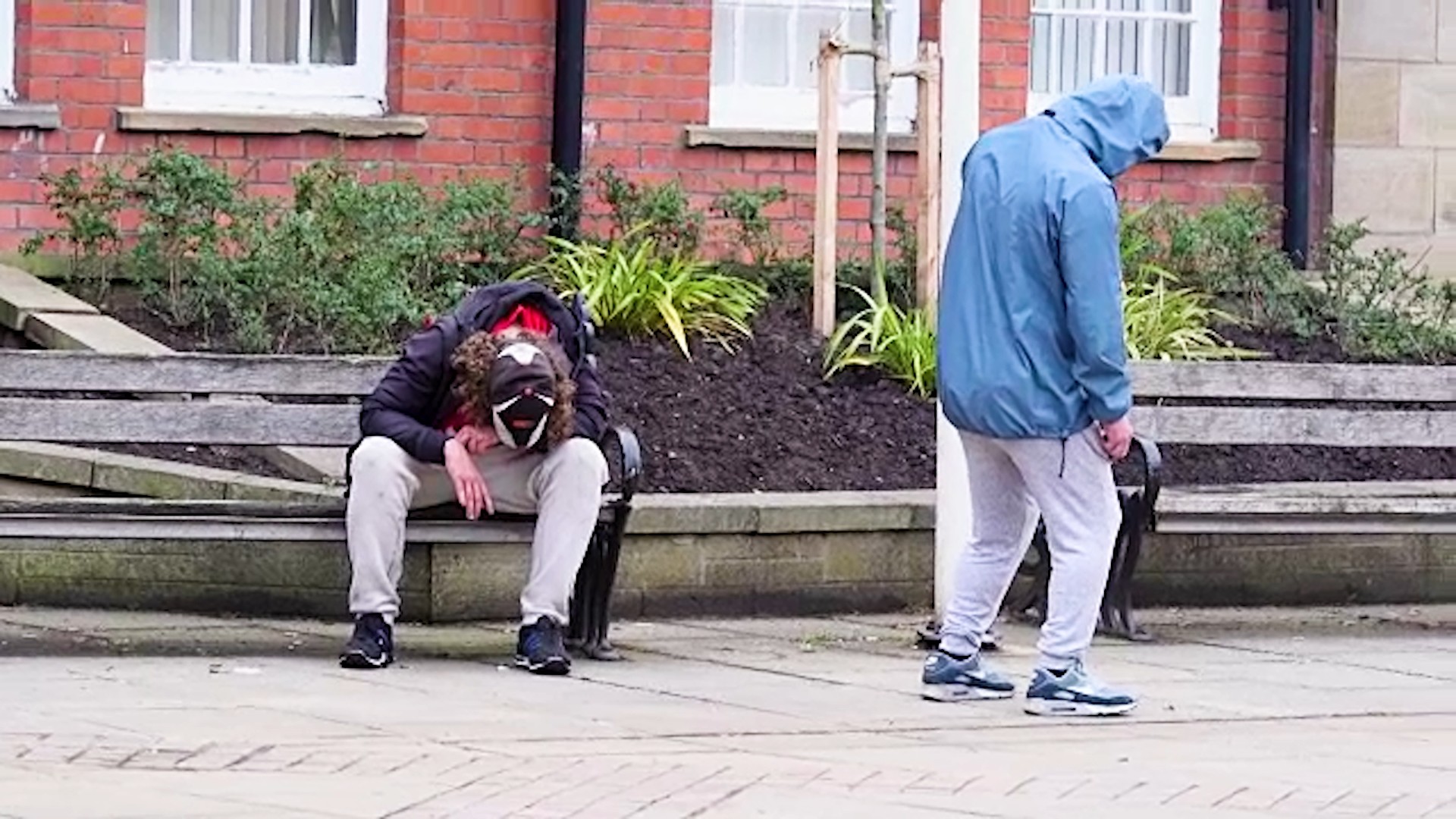Boxer shorts being checked at HMP Pentonville prison in London. Photo by Andrew Aitchison/In pictures via Getty Images
Pants and socks laced with potent drugs are being smuggled into UK prisons so inmates can get high.Prison authorities are increasingly finding a variety of clothes soaked with highly toxic synthetic cannabinoids, better known as “Spice”, and etizolam, a strong benzo. Prisoners either put the clothes in water to extract the substances they’ve been soaked in, turn it into psychoactive tea by boiling strands, or smoke or vape the ripped-up, drug-drenched material. Drug-soaked clothes is the latest tactic in a long-running game of hide and seek between the authorities and prisoners who want to get high – mainly because they’re so bored and stressed. Most drugs arrive into prisons via visitors, corrupt prison staff and packed into plastic capsules stored up the bum of incoming prisoners. But prisoners have had to come up with an array of other methods, including substances being soaked into letters and drawings, inserted into dead pigeons thrown over the wall, flown in via drone or carried in by drug mule cats.The clothing tactic has been discovered across the prison system in Scotland, as well as at HMPs Leeds, Doncaster, Rochester and Wrexham in England and Wales.A spokesman for the Scottish Prison Service told VICE World News: “We are increasingly finding clothing such as underwear, socks, towels and jeans sent into prisons impregnated with drugs.‘Clothing that is found to test positive for drugs is impounded or destroyed. We have heard that prisoners put the clothes in water, leach out the drugs and drink it. Some use these clothes to make etizolam tea.” The clothes soaking method has been adopted since the authorities got wise to inmates receiving letters and drawings laced with drugs. Prisons now make photocopies of letters and drawings sent by mail, instead of giving out originals. A study carried out by the Leverhulme Research Centre for Forensic Science at Dundee University, which tests items for drugs in Scottish prisons, said drugs “can be infused in active doses into herbal material, paper, clothing, and other materials which are then smoked or vaped”. It said that the impregnation of everyday materials with synthetic cannabinoids and etizolam made them difficult to detect by prison authorities. A routine inspection at HMP Rochester by the Prison’s Inspectorate in October found prisoners had complained about long delays in receiving clothes from family and friends because the prison had started routinely testing boxer shorts and socks after finding some had been soaked in drugs. Rob Ralphs, a criminologist at Manchester Metropolitan University who specialises in prison drug markets, said that in Scotland the authorities had frequently come across clothes and bedding impregnated with etizolam, a drug driving record deaths there outside prisons. He said inmates rip up the drug-soaked textiles into shreds and boil them in a kettle and call it “etizolam tea”. “As forensic chemists have developed methods of detecting these substances on paper and prisons have started to photocopy mail, we have started to hear about Spice and benzodiazepines such as etizolam entering the prison estate impregnated on clothing and bedding. “This is a game of cat and mouse between prison staff and prisoners which the mice are clearly winning,” said Ralphs. He said that prison drug clampdowns have simply led to prisoners using more dangerous drugs.“It is over 25 years since mandatory drug tests were introduced in our prison system, with the aim of reducing prison drug use. During this time, we have seen prisoners switch from cannabis to heroin, as heroin is detectable for less than 48 hours, compared to up to 30 days for cannabis. Then we witnessed the shift to synthetic cannabinoids as the prison drug of choice, as they were hard to detect through smell, or existing drug tests.” Ralphs said that when the smoke-free prison policy was rolled out in 2018 it led to a shift from smoking the weed-looking form of Spice (plant matter sprayed with the synthetic cannabinoids) to smoking it on impregnated paper “as this was easier to conceal in room searches and security were looking for plant matter”. He said vapes introduced as part of the smoke free policy which banned tobacco, were being used to ignite the Spice infused paper.“What we have learnt from the past 25 years is that prisoners are inventive and find new ways to circumnavigate the security response, making attempts to prevent drug use in the prison estate futile, leading to more harms to users, more disruption to the prison estate but seemingly not leading to any reduction in prison drug use,” said Ralphs. “When drugs are sprayed onto paper or clothing and consumed in these methods, it is much more difficult for the user to gauge the amount being consumed. This is making drug use in prison settings more unpredictable and dangerous.” Many drug deaths in prison are linked to the use of Spice, according to the Prisons and Probation Ombudsman (PPO).The latest data on drug deaths in prison from the PPO, seen by VICE World News, shows the agency launched 203 investigations into drug related deaths in the prison system in the last five years, compared to 66 during the five years before that – a three-fold rise. The PPO said Spice kills some young, otherwise healthy inmates due to its ability to increase heart rate, raise blood pressure, reduce blood supply to the heart, slow down breathing, and cause vomiting. The agency had hoped the suspension of social visits and COVID restrictions would reduce the opportunities for smuggling drugs into prison, and therefore reduce drug-related deaths. But it said that “unfortunately, this does not seem to have been the case”.Spice is commonly linked to young offenders and the street homeless population outside of prisons. But the drug has caused a steep rise in addiction, health emergencies, violence, bullying and debt behind bars. In November the head of the Prison’s Officers Association called for action after he said the use of Spice in jails had reached a “very dangerous level” and was causing chaos in UK prisons. The government's own Prisons Inspectorate has described Spice as "the most serious threat to the safety and security of the prison system."Drugs are popular in prison due to a lack of any meaningful activity – a problem in UK prisons despite research that shows being productive in jail makes inmates less likely to reoffend after they are released. Peter Dawson, director of the Prison Reform Trust, said the solution to the UK’s prison Spice epidemic is not just about trying to stop drugs coming in.“Reducing demand is the bigger challenge. That's about giving prisoners reasons not to use drugs - a daily routine that's full and worthwhile, easy contact with families, good mental health support whether you have a substance misuse problem or not, the chance to get fit and stay fit, and perhaps above all some hope for the future.”
Many drug deaths in prison are linked to the use of Spice, according to the Prisons and Probation Ombudsman (PPO).The latest data on drug deaths in prison from the PPO, seen by VICE World News, shows the agency launched 203 investigations into drug related deaths in the prison system in the last five years, compared to 66 during the five years before that – a three-fold rise. The PPO said Spice kills some young, otherwise healthy inmates due to its ability to increase heart rate, raise blood pressure, reduce blood supply to the heart, slow down breathing, and cause vomiting. The agency had hoped the suspension of social visits and COVID restrictions would reduce the opportunities for smuggling drugs into prison, and therefore reduce drug-related deaths. But it said that “unfortunately, this does not seem to have been the case”.Spice is commonly linked to young offenders and the street homeless population outside of prisons. But the drug has caused a steep rise in addiction, health emergencies, violence, bullying and debt behind bars. In November the head of the Prison’s Officers Association called for action after he said the use of Spice in jails had reached a “very dangerous level” and was causing chaos in UK prisons. The government's own Prisons Inspectorate has described Spice as "the most serious threat to the safety and security of the prison system."Drugs are popular in prison due to a lack of any meaningful activity – a problem in UK prisons despite research that shows being productive in jail makes inmates less likely to reoffend after they are released. Peter Dawson, director of the Prison Reform Trust, said the solution to the UK’s prison Spice epidemic is not just about trying to stop drugs coming in.“Reducing demand is the bigger challenge. That's about giving prisoners reasons not to use drugs - a daily routine that's full and worthwhile, easy contact with families, good mental health support whether you have a substance misuse problem or not, the chance to get fit and stay fit, and perhaps above all some hope for the future.”
Advertisement
Advertisement
Advertisement
Advertisement

Advertisement
